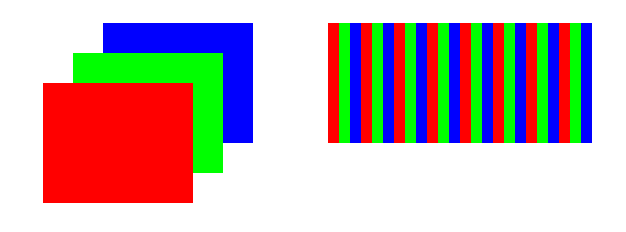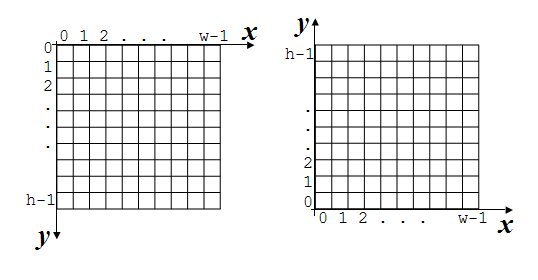Image Representation Overview
Width and Height
In the IM library images are 2D matrices of pixels defining width and height. Stacks, Animations, Videos and Volumes are represented as a sequence of individual images.
Color Space
The pixels can have one of several color spaces:
IM_RGBIM_MAPIM_GRAYIM_BINARYIM_CMYKIM_YCBCRIM_LABIM_LUVIM_XYZ.
IM_MAPis a subset of theIM_RGBcolor space. It can have a maximum of 256 colors. Each value is an index into a RGB palette.
IM_GRAYusually means luma (nonlinear Luminance), but it can represent any other intensity value that is not necessarily related to color.
IM_BINARYis a subset of theIM_GRAYcolor space, and it has only 2 colors black and white. Each value can be 0 or 1. But for pratical reasons we use one byte to store it.The other color spaces are standard CIE color spaces, except CMYK that does not have a clear definition without other parameters to complement it.
Data Type
There are several numeric representations for the color component, or several data types:
IM_BYTEIM_USHORTIM_INTIM_FLOATIM_CFLOAT.There is no bit type, binary images use 1 byte (waist space but keep processing simple).
Color Mode Flags
To avoid defining another image parameter we also use a parameter called color_mode that it is composed by the color_space plus some flags, i.e. color_mode = color_space + flags. The flags are binary combined with the color space, for example color_mode = IM_RGB | IM_XXX. And several flags can be combined in the same color_mode.
There are 3 flags:
IM_ALPHAIM_PACKEDIM_TOPDOWNWhen a flag is absent the opposite definition is assumed. For simplicity we define some macros that help handling the color mode:
imColorModeSpaceimColorModeHasAlphaimColorModeIsPackedimColorModeIsTopDownColor Components Packaging (
IM_PACKED or unpacked)The number of components of the color space defines the depth of the image. The color components can be packed sequentially in one plane (like rgbrgbrgb...) or separated in several planes (like rrr...ggg...bbb...). Packed color components are normally used by graphics systems. We allow these two options because many users define their own image structure that can have a packed or an separated organization. The following picture illustrates the difference between the two options:

(flag not defined) IM_PACKEDSeparated and Packed RGB Components
Alpha Channel (
IM_ALPHA or no alpha)An extra component, the alpha channel, may be present. The number of components is then increased by one. Its organization follows the rules of packed and unpacked components.
Orientation (
IM_TOPDOWN or bottom up)Image orientation can be bottom up to top with the origin at the bottom left corner, or top down to bottom with the origin at the top left corner.
IM_TOPDOWN(flag not defined)Top Down and Bottom Up Orientations
Examples
IM_RGB|IM_ALPHA- rgb color space with an alpha channel, bottom up orientation and separated components
IM_GRAY|IM_TOPDOWN- gray color space with no alpha channel and top down orientation
IM_RGB|IM_ALPHA|IM_PACKED- rgb color space with an alpha channel, bottom up orientation and packed components
Raw Data Buffer
So these four parameters define our raw image data: width, height, color_mode and data_type. The raw data buffer is always byte aligned and each component is stored sequentially in the buffer following the specified packing.
For example, if a RGB image is 4x4 pixels it will have the following organization in memory:
RRRRRRRRRRRRRRRRGGGGGGGGGGGGGGGGBBBBBBBBBBBBBBBB - for non packed components 0 1 2 3 0 1 2 3 0 1 2 3RGBRGBRGBRGBRGBRGBRGBRGBRGBRGBRGBRGBRGBRGBRGBRGB - for packed components 0 1 2 3In bold we visualy marked some lines of data.
imImage
We could restrict the data organization by eliminating the extra flags, but several users requested these features in the library. So we keep them but restricted to raw data buffers.
For the high level image processing functions we created a structure called imImage that eliminates the extra flags and assume no alpha channel, bottom up orientation and separated components.
The imImage structure is defined using four image parameters: width, height, color_space and data_type. It is an open structure in C where you can access all the parameters. In addition to the 4 creation parameters there are many auxiliary parameters like depth, count, line_size, plane_size and size.
